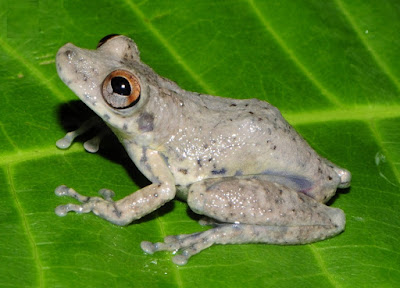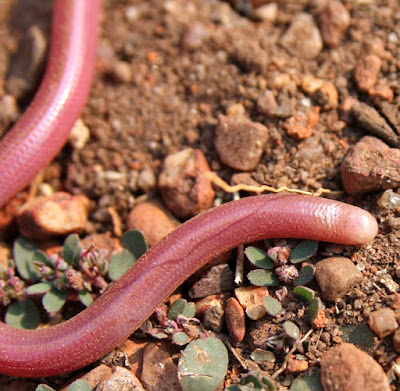[Most Recent Entries] [Calendar View]
Monday, February 12th, 2018
| Time | Event | ||||
| 12:18p | [Herpetology • 2018] Scinax ruberoculatus • A New Species of Amazonian Snouted Treefrog (Hylidae: Scinax) with Description of A Novel Species-habitat Association for An Aquatic Breeding Frog
Abstract The genus Scinax is one of the most specious genera of treefrogs of the family Hylidae. Despite the high number of potential new species of Scinax revealed in recent studies, the rate of species descriptions for Amazonia has been low in the last decade. A potential cause of this low rate may be the existence of morphologically cryptic species. Describing new species may not only impact the taxonomy and systematics of a group of organisms but also benefit other fields of biology. Ecological studies conducted in megadiverse regions, such as Amazonia, often meet challenging questions concerning insufficient knowledge of organismal alpha taxonomy. Due to that, detecting species-habitat associations is dependent on our ability to properly identify species. In this study, we first provide a description of a new species (including its tadpoles) of the genus Scinax distributed along heterogeneous landscapes in southern Amazonia; and secondly assess the influence of environmental heterogeneity on the new species’ abundance and distribution. Scinax ruberoculatus sp. nov. differs from all nominal congeners by its small size (SVL 22.6–25.9 mm in males and 25.4–27.5 mm in females), by having a dark brown spot on the head and scapular region shaped mainly like the moth Copiopteryx semiramis (or a human molar in lateral view, or a triangle), bicolored reddish and grey iris, snout truncate in dorsal view, bilobate vocal sac in males, by its advertisement call consisting of a single pulsed note with duration of 0.134–0.331 s, 10–23 pulses per note, and dominant frequency 1,809–1,895 Hz. Both occurrence and abundance of the new species are significantly influenced by silt content in the soil. This finding brings the first evidence that edaphic factors influence species-habitat association in Amazonian aquatic breeding frogs. Scinax ruberoculatus sp. nov. Scinax sp. 7 Ferrão et al. (2016), p. 7, 9, Figs. 2–3. Diagnosis. A small species of the genus Scinax characterized by the following combination of characteristics: SVL 22.6–25.9 mm in males and 25.4–27.5 mm in females; snout truncate in dorsal view and rounded in lateral view; tarsal tubercles indistinct; tubercles on the lower jaw, knee, and heel absent; diameter of disc on fourth finger represents 60% of tympanum diameter; skin on dorsum smooth; dentigerous processes of vomers triangular; bilobate vocal sac and nuptial pads in males; Finger III<V; in life, ground colour of dorsum light grey or light brown; a large brown or grey spot on the head and scapular region shaped like the moth of the species Copiopteryx semiramis (Cramer, 1775), or a human molar in lateral view, or a triangle; dorsal or dorsolateral stripes absent; whitish cream stripe in the lower portion of the flanks; anterior and posterior surfaces of thighs brown; webbing between toes light to dark grey; belly white to greyish-white with light brown to brown blotches laterally; males with vocal sac semi-translucent white; iris bicolored, upper half reddish, lower half grey; advertisement call consisting of a single pulsed note, with note duration of 0.134–0.331 s, 10–23 pulses/note, dominant frequency 1809–1895 Hz; tadpoles with labial teeth formula 2 (2)/3, absence of labial arm, and presence of dark brown blotch on the distal part of the tail. ..... Etymology. The specific epithet ruberoculatus is composed of two words in Latin, “ruber” (red) and “oculatus” (having eyes). The name is an adjective in concordance with the masculine gender of the genus Scinax and refers to the reddish colour of the upper part of the iris. Suggested English common name: ‘Red-eyed Snouted Treefrog’. Notes on the natural history. Individuals of Scinax ruberoculatus sp. nov. were observed mainly in primary and old-growth secondary lowland rainforests (39–68 m a.s.l.) where they occupied edge situations. Its breeding season was correlated with the rainy season in the northern PMRI (November–March). Active males vocalized while sitting on the vegetation in horizontal position 1–2 m above the ground around temporary ponds. The number of calling males was higher on rainy nights. In two large temporary ponds (>25 m2) males of S. ruberoculatus sp. nov. shared calling sites with Dendropsophus minutus (Peters, 1872), D. rhodopeplus (Günther, 1858), D. sarayacuensis (Shreve, 1935), and Scinax sp. 1 (sensu Ferrão et al., 2016). Only males of S. ruberoculatus sp. nov. were found in small temporary ponds (<4 m2). During the day, inactive individuals were observed between leaves of palm trees. Miquéias Ferrão, Rafael de Fraga, Jiří Moravec, Igor L. Kaefer and Albertina P. Lima. 2018. A New Species of Amazonian Snouted Treefrog (Hylidae: Scinax) with Description of A Novel Species-habitat Association for An Aquatic Breeding Frog. PeerJ. 6:e4321. DOI: 10.7717/peerj.4321 | ||||
| 3:25p | [Herpetology • 2018] Letheobia akagerae • A New Blind Snake of the Genus Letheobia (Serpentes: Typhlopidae) from Rwanda with Redescriptions of L. gracilis and L. graueri and the Introduction of A Non-invasive Preparation Procedure for Scanning Electron
Abstract A new species of blind snake in the genus Letheobia is described from Akagera National Park in eastern Rwanda. The new species is most similar to species of the L. gracilis complex, particularly L. gracilis and L. graueri. It differs from all other species of the genus by a unique combination of morphological characters, including the highest number of middorsal scale rows (834) and the most extreme elongation (total-length/midbody-width ratio 131) of all species in the genus and of any species of snake in the world; 22-22-22 longitudinal scale rows; snout in dorsal profile rounded, in lateral profile bluntly rounded with an angular horizontal edge ventrally; rostral broad, posteriorly rounded; eyes invisible; supralabial imbrication pattern T-0; tail short (1.3 percent of total length) with an apical spine; and a pink life colouration. The holotype of the new species was collected in gallery forest at a lake shore surrounded by savanna at 1300 m elevation. We produced scanning electron microscope images of the heads of the investigated specimens applying a liquid-substitution preparation procedure which does not require coating or drying and thus does not irreversibly damage the investigated samples. The obtained images allow an easy and more accurate examination of the scalation. Keywords: Reptilia, Taxonomy, morphology, Letheobia gracilis, Letheobia graueri, Akagera National Park, liquid substitution, glycerol, uncoated specimens, SEM of liquids, infiltration
Etymology. The specific epithet refers to the type locality, the Akagera National Park in eastern Rwanda. Distribution, habitat and conservation status. The holotype of Letheobia akagerae was found when soil was dug during construction work. The type locality is in gallery forest near the shores of Lake Ihema at around 1290 m a.s.l. Three additional specimens were observed and photographed in tree savanna on a nearby hilltop in the headquarters area of the national park slithering on the ground after heavy rainfalls during the day. All of them showed the extreme elongation of the body and a pinkish live colouration but unfortunately none were retained for further examination. The species may be more widespread and even occur in cultivated areas outside the national park. Until further data on the distribution and abundance of the species becomes available, we recommend L. akagerae be classified as Data Deficient according to the IUCN Red List Criteria ( IUCN 2017). J. Maximilian Dehling, Harald H. Hinkel, Hans-Jürgen Ensikat, Kenny Babilon and Eberhard Fischer. 2018. A New Blind Snake of the Genus Letheobia (Serpentes: Typhlopidae) from Rwanda with Redescriptions of L. gracilis (Sternfeld, 1910) and L. graueri (Sternfeld, 1912) and the Introduction of A Non-invasive Preparation Procedure for Scanning Electron Microscopy in Zoology. Zootaxa. 4378(4); 480–490. DOI: 10.11646/zootaxa.4378.4.2 |
| << Previous Day |
2018/02/12 [Calendar] |
Next Day >> |







